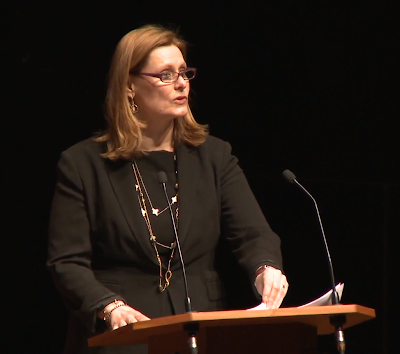Sat waiting for Julia Hobsbawm to begin her session, I saw immediately the difference between those attending the session and Julia herself. Those drawn to a talk entitled 'Shyness in networking: How to love something you distrust' were just that; shy and distrustful. Ladies shuffled to their seats choosing those around the edges first and often leaving a spare seat between them and their nearest neighbour.
I was attending any of these conference talks alone. I felt conspicuous anyway so I figured I had nothing to lose by choosing a seat right in the middle but even I didn't stride to the front row, instead going for a fairly safe 3rd row back.
Julia Hobsbawm, Media Woman of the Year 2012, had arrived looking cool, calm and impeccably dressed. Taking a chair centre stage, she began to do a little work with the air of someone who was completely unwatched. Looking up, straight into my wide eyed gaze, Julia gave me a proper rabbit in the headlights moment.
A lady sat next to me and I looked over, giving her the signal that it was OK to chat. She was working for a London based NGO and like me was attending the talk to unlock the ultimate secrets of networking. I think we'd set ourselves up for a bit of a reality check though. The big secret? There isn't really a secret. it's all there in the real world. We just have to open our eyes and see it for ourselves.
Apparently 90% of people are shy of networking. Wonder if that statistic would vary between communities with different cultural levels of social integration? We were advised to learn to overcome this shyness by not being so intimidated by the implied level of intimacy. Living up to 'labels' can inhibit us whether these are labels presented by our peer group or self imposed.
To network successfully you need to have a genuine interest in thebnpeople you're looking to meet and have some ability to read a room. I assume that reading a room means a level of social awareness that stops you from interrupting and disrupting an existing positive interaction between others and allows you so spot opportunities for your own interactions.
Relationships follow the same trajectory as networking. They are a business relationship often born from the same tyuoe of random interaction that crystallises into a lasting friendship. This could be why one of the worst laces to network is a conference as it is a forced interaction on an often shallow level.
Recommended reading: Weak Tie Theory by Michael Granovetter
To be a good networker, you have to know who you are. By knowing who you are you can connect with people working outwards from your position. Much in the way that paths lead to trees which can lead you to birds.
Julia, to my surprise, almost completely slated social media as a waste of time. In our current social media obsessed culture we are driven by our own stats; how many twitter followers, how many Facebook friends, but these are often very weak ties. I'm not sure if I agree that social media creates barriers but I understand that being face to face for networking proves that you're making time for networking . Social media, Julia concedes is useful for information gathering and renewing existing connection.
Networking must be include within your allocated business or working time. Time management is crucial to cresting a strong work/life balance. Roughly speaking a rule of thirds should be used to divide your time. Only one third to be allocated to work, one third for sleeping and eating, with the remaining third given over to your realistic existence and wellbeing. Believing that you can run your life without speciffucalky giving yourself time to do the laundry, make those dentist appointments of just take 5 for yourself is a sure fire path to burn out.
Bearing this in mind, a savvy business person wants to maximise the efficiency of their networking time.
Make sure you are walking into a room worth walking into.
Enter the room and find someone like you or someone you would want to talk to. If no one present matches these criteria, you are in the wrong room. Don't spend more time there than you have to, you are only wasting your time and that of the other people there.
A good tip is to aim for curated gatherings. Have something to say. However small, have something that you know well and can talk about with ease. Doesn't mean you have to talk about this one thing and this one thing only but it will give you a comfortable start to any conversation. An interaction which can then lean on to other mutually interesting subjects.
If you genuinely want change, you can make it happen. Specific interest groups can limit your network. An artist who only goes to art groups will only ever meet other artists. An artist who goes to an event for small businesses has the potential to meet people from many walks of life but who are on a similar business trajectory.
On a final note, don't be that salesman at the party. Knowledge networking is not about transactional results. And remember to be interested. The biggest conversation killer is disinterest. That's where you'll come unstuck.
Julia Hobsbawn can be found on
twitter or pop over to her
website.













